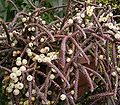Cassytha is a genus of some two dozen species of obligately parasitic vines in the family Lauraceae. Superficially, and in some aspects of their ecology...
25 KB (2,882 words) - 22:27, 29 July 2024
Cassytha filiformis or love-vine is an orangish, wiry, parasitic vine in the family Lauraceae. It is found in coastal forests of warm tropical regions...
9 KB (768 words) - 11:48, 15 June 2023
trees and shrubs, especially in tropical and temperate climates. The genus Cassytha is unique in the Lauraceae in that its members are parasitic vines. Most...
28 KB (2,974 words) - 09:42, 2 November 2024
Cassytha pubescens is a native Australian hemiparasitic vine species, in the Laurel family. Common names for the species include devils twine, dodder-laurel...
7 KB (835 words) - 00:22, 7 May 2023
Cassytha melantha is a parasitic vine. Common names include coarse dodder-laurel and large dodder-laurel. The fruits are about 10–15 millimetres (0.39–0...
3 KB (168 words) - 01:02, 14 October 2023
Cassytha racemosa (common name - dodder laurel) is a parasitic perennial in the Lauraceae family. It is found in Western Australia. The species was first...
2 KB (124 words) - 16:05, 12 December 2023
Cassytha glabella, commonly known as the slender devil's twine, is a common twining plant of the Laurel family, found in many of the moister parts of Australia...
3 KB (391 words) - 00:22, 7 May 2023
twine from one plant to another, parasitic plants such as Cuscuta and Cassytha have been shown to convey phytoplasmal and viral diseases between plants...
14 KB (1,304 words) - 11:49, 8 February 2024
Cactus pendulus Sw. Cactus quadrangularis Haw. Cassytha baccifera J.S.Muell. Cassytha filiformis Mill. Cassytha polysperma Aiton ex Gaertn. Cereus bacciferus...
8 KB (391 words) - 21:39, 11 October 2024
Parkinson's disease because of its stimulating effect on dopamine receptors. Cassytha filiformis, a plant used in African traditional medicine, contains many...
5 KB (513 words) - 16:52, 9 September 2023










